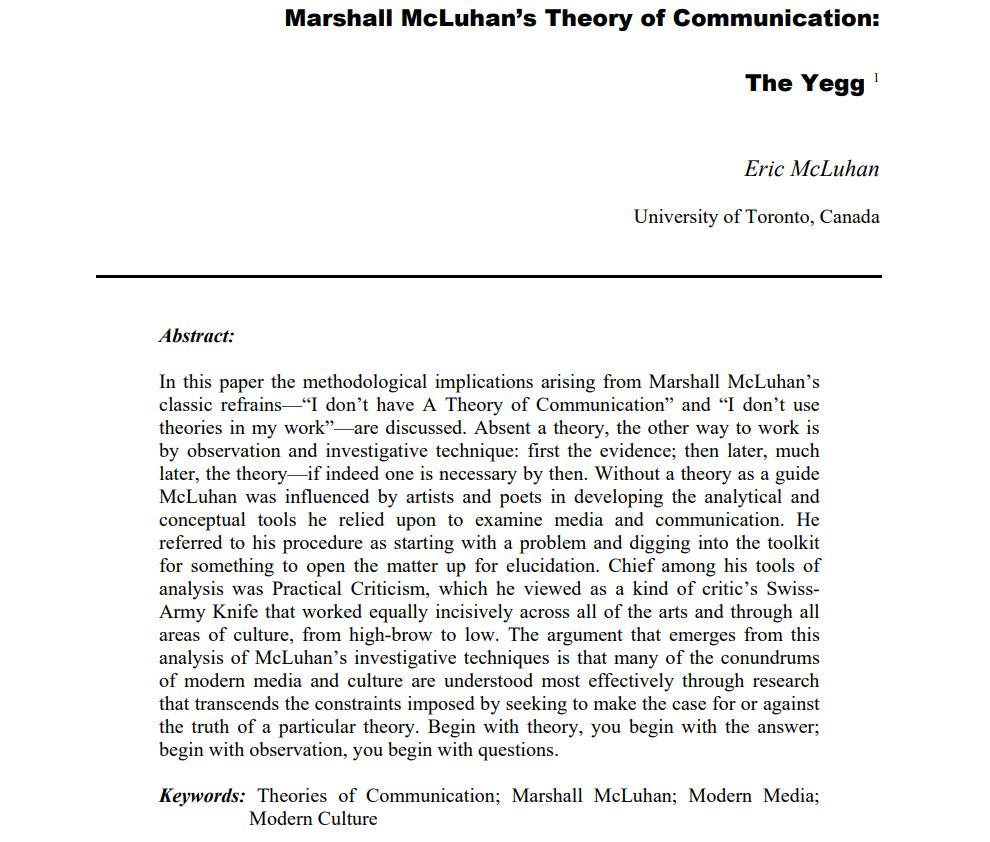For Andrew…
The same TLS issue1 of August 6, 1964 with McLuhan’s ‘Statement on Culture and Technology’ featured a piece by William Burroughs: ‘The Literary Techniques of Lady Sutton-Smith‘. There is good evidence that McLuhan read Burroughs’ piece and was impressed by it.
In the first place, McLuhan wrote an article on Burroughs in The Nation2 that appeared only a few months after their joint appearance in the TLS. Presumably McLuhan was prompted to write his ‘Notes on Burroughs‘ for The Nation after reading Burroughs’ TLS note on ‘Literary Techniques’.
In the second place, there are passages in Burroughs’ piece which would have impressed McLuhan as giving off a whiff of central aspects of his own thoughts — or, indeed, as something he needed to consider further thanks to Burroughs:
- Words know where they belong better than you do. I think of words as being alive like animals. They don’t like to be kept in pages.3
- Your words spelt out whose words?
- muttering voices looking for a role…4
- Before you can write you must learn to listen (…) don’t talk to yourself (…) forget [the] me
- I’m a little hard of hearing
- Any intersection point in present time contains all your past times and maybe your future time as well.
In the third place, the cut-up method that Burroughs’ TLS piece both describes and illustrates was a way (Gk οδός, hence meth-od) of deploying the com/plexity of language — its exfoliations and infoldings — and the gaps which are required for such com/plexity.
Forget me from old Tuesday intersection points…I on the other side…sad muttering voices…a few errands…An old junky writes in the margin dim jerky far away…Get that picture? You know how to read behind a novel? Future fog across arrivals and departures? Smell of ashes rising from the typewriter?
The cut-up method is a practical application of “the gap is where the action is”:
Burroughs uses what he calls “Brion Gysin’s cut-up method” (…) To read the daily newspaper in its entirety is to encounter the method in all its purity. Similarly, an evening watching television programs is an experience in a corporate form — an endless succession of impressions and snatches of narrative. Burroughs is unique only in that he is attempting to reproduce in prose what we accommodate every day as a commonplace aspect of life in the electric age. If the corporate life is to be rendered on paper, the method of discontinuous nonstory must be employed. (McLuhan, Notes on Burroughs)
In the fourth place, it must have been a very rare (and presumably much appreciated) event in McLuhan’s life to encounter a word he didn’t know. In earlier times he had delighted in using words which no one had ever heard of. Now Burroughs offered him one: “Yegg Men”.5 Burroughs had gone to Chicago to hear a course of Korsbinski lectures in 1939 and then lived there on the near north side in 1942-1943.6 He must have had these years in Chicago on his mind when he wrote the TLS piece since he mentions North Clark St three times in the course of its few pages. And ‘Yegg Man’ was Chicago slang for “hobo burglar, safe-breaker, criminal beggar”.
McLuhan would have been the all more delighted with this new word since he could identify with it: he himself was a self-professed “safe-breaker”:
Most of my work in the media is like that of a safe-cracker. In the beginning I don’t know what’s inside. I just set myself down in front of the problem and begin to work. I grope, I probe, I listen, I test — until the tumblers fall and I’m in. That’s the way I work with all these media. (Stearn interview, 1967)
I grope, I listen, I test, I accept and discard; I try out different sequences — until the tumblers fall and the doors spring open. (Playboy interview, 1969)
Hence it was, when Eric McLuhan came to describe ‘Marshall McLuhan’s Theory of Communication‘ — this was in 2008, almost thirty years after his father’s death and 44 years after the Burroughs and McLuhan TLS pieces — that he called his essay ‘The Yegg’. And the definition he offered there for the word was “an itinerant professional safe-cracker”.
- Reprinted with the McLuhan and Burroughs articles in Astronauts of Inner-Space in 1966. ↩
- ‘Notes on Burroughs‘, The Nation, 199:21, December 1964, pp. 517-519. ↩
- Compare McLuhan from over a decade before: “words can be regarded not as signs but as existent things, alive with a physical and mental life which is both individual and collective” (‘James Joyce: Trivial and Quadrivial’, 1953). In that same essay McLuhan commented on puns like Burroughs’ on cages/pages — “puns in the Wake are a technique for revealing the submerged drama of language, and Joyce relied on the quirks, ‘slips’, and freaks of ordinary discourse to evoke the fullness of existence in speech. All his life he played the sleuth with words, shadowing them and waiting confidently for some unexpected situation to reveal their hidden signatures and powers. For his view of the poet was that he should read, not forge, the signatures of things.” ↩
- Burroughs “muttering voices” would have put McLuhan in mind of FW, of course. In Through the Vanishing Point, he writes of “the auditory mumble” (63). That all human being might be considered as “put-on”, masks and roles was a central feature of McLuhan’s lifetime method. ↩
- Eric McLuhan was back from his stint on the US Air Force at this time and would certainly have shared in his father’s discovery. ↩
- Burroughs chronology ↩

